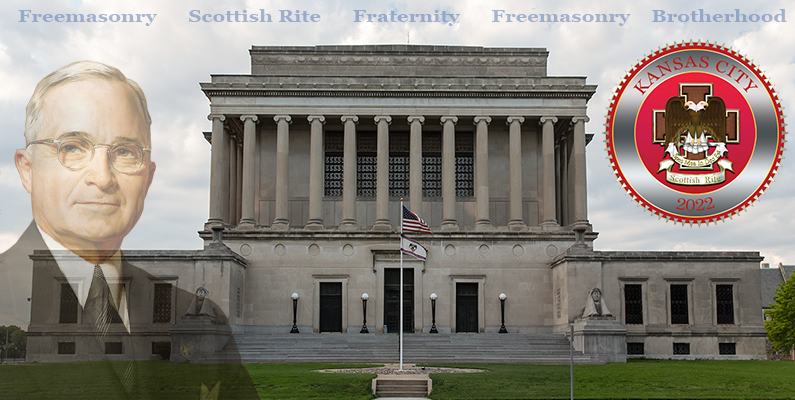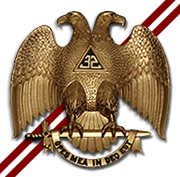
Scottish Rite History

Dr. Isaac M. Ridge MD, 32°
(Jul 9, 1825-May 7, 1907) Born: Adair County, Kentucky
1849 - Raised, Heroine Lodge #104, Kansas City, Mo
32°
Consistory of Western Missouri, Kansas City, #127
1895 - Wise Master Areiopagus Chapter of Rose Croix
Charter member, Kansas City Chapter, No. 28
Charter Member, Knight Templar Commandery
1891 - Member #310, Ararat Shrine Temple
Occupation: Physician
Alum: Transylvania University, Lexington, Ky
Interred: Mt Washington Cemetery, Independence, Mo
The life record of Dr. Isaac M. Ridge if given in detail would present a complete history of the early days of Missouri and especially of Kansas City. He was reputed to be the first college graduated physician to locate in Kansas City. Brother Ridge was born in Adair county, Kentucky, July 9, 1825 to William and Sophia (Dillingham) Ridge. His father was a native of Maryland who migrated to Kentucky in 1800, and following his marriage there went to Lafayette County, Missouri, in 1833.
Dr. Ridge, obtained his education in a private school and in an academy at Dover, Missouri. There he also took up the study of medicine under the tutelage of Dr. Warren of that town. He subsequently became a student in the Transylvania University at Lexington, Kentucky from which he was graduated in 1848 with the first honors of his class.
On the 1st day of June of the same year Dr. Ridge located for practice at the old city of Kansas, a settlement of nearly 400, sometimes called Westport Landing but now as Kansas City. He was the first and for many years the only only college graduated physician in the city and he gained preeminence in surgery and medicine. He made horseback trips to his patients daily into all adjoining counties and across the river into the territory of Kansas. His kindness and skill gained the friendship of the Wyandotte Indians and gained a great influence over them, which extended rapidly to other tribes. When roving red men were a part of the life of the great west, Dr. Ridge was honored by the Indians at one of the "great corn feasts," by being made a member of their tribe, at which celebration he was given the name of "Little Thunder," in Indian American, from his positive manner and directness of speech, and sonorous voice which were brought into play when his instructions were disobeyed, for they regarded his cures as miraculous.
Treat the Indians, said the Doctor, with honesty, uprightness and truthfulness and they will always be your staunch supporters; deceive them, they never forgive nor forget, neither would they lose an opportunity of showing their complete disgust for those whom they think wronged them.
In October, 1861, just before the battle of Lexington, Dr. Ridge was compelled by the order to attend General Slack's Division as chief surgeon of his staff, being so ordered by General Sterling Price, and in this battle, by reason of his position, he was able to save the lives of a number of his warmest friends who were fighting on the other side. In his official capacity he attended all of those who were wounded in the engagement.
President Lincoln, appreciating the wonderful ability of Dr. Ridge, not only offered him a commission but any position in his province on the Potomac if he would accept service in the army. These offers were carried to the Doctor through high officials, but to all entreaties the Doctor turned a deaf ear, so strong were his Masonic vows not to take up arms against the government under which he lived and he could not fight against his relations and friends.
Just at the close of the war he was shot in the leg by a highwayman, but managed to escape with his life. The bullet accompanied him to his grave. Following the close of hostilities and the more rapid up building of Kansas City, other physicians became residents of Kansas City and Dr. Ridge at all times received them kindly, assisting many in getting a business start. He did not take an active part, however, in the management of the medical colleges, preferring to continue in the private practice of his profession, though always a welcome lecturer at all of the colleges.
Throughout the years of his practice his patronage steadily grew in extent and importance until 1875, when he retired from the more active duties of his chosen calling, confining himself to office practice and consultation, and until two years previous to his death he was found daily at his office in the Ridge building.
A monument to the enterprise of Dr. Ridge is the beautiful Ridge building, which is recognized as one of the best office buildings west of the Mississippi. It extends from Main to Walnut street. In the section fronting on Walnut street is about one hundred rooms. The second story is used for office purposes and the third and fourth floors are devoted to the Masonic fraternity including being the home for the Valley of Kansas City Scottish Rite from 1892 to 1904. The main street building is six stories in height; has about two hundred office rooms, beside six large stores, with basement.
Dr. Ridge, who was appointed city physician, giving him the honor of being the first city physician Kansas City had, and he held this position for over ten years, when he positively resigned, refusing to be reappointed several times. During this period, owing to the exigencies of the times and the position Dr. Ridge found himself, with the assistance of a valet not only city physician, but steward, nurse, undertaker, and grave supervisor, for which services he was to have been paid by the city. The epidemic of smallpox in its first raid took off a hundred or more, patients, then cholera reappearing chiefly among the Belgians who came by the boat load up the river, swept them off by the hundreds. During this term of service Dr. Ridge had under his care several thousand patients, refugees and soldiers, in and out of the hospitals, for which he was never paid or received a dollar, practicing under duress and for humanity's sake.
In 1850, Mormons camped here on their way to Utah, while here they were taken with severe illness, smallpox and cholera being their principal troubles. The success of Dr. Ridge in relieving the Mormons, was so phenomenal, that Brigham Young offered him any position he might wish, and named an immense salary, even for these days, if he would go with them and be the physician of the Mormons, which was declined with thanks.
Dr. Ridge was always a public-spirited Kansas Citian, donating large sums to many public enterprises for the city's benefit and giving it much land without price, especially that square at the "Junction." Also in 1881 he gave to the city four and one-half feet to widen Ninth street when the property was selling at seven hundred and fifty dollars per foot. Property owners, adjoining this strip in 1908 refused offers of over four thousand dollars per foot. Dr. Ridge always approved of parks and boulevards, but objected seriously to the manner of getting the same. Dr. Ridge was always progressive. The Kansas City Enterprise, the first newspaper, was owned by the stockholders, who were: Dr. Benoist Troost, Colonel McCarthy, Colonel E. M. McOee, Joseph and Henry Chick. H. M. Northrup, Dr. Isaac M. Ridge, Judge Thomas A. Smart, Dr. .Johnston Lykins, John S. Campbell, Silas Armstrong, Patrick. Philip and John Shannon, Jesse Riddlesbarger. Thomas Johnson of Shawnee Mission, and Captain Chouteau. They had no regular editor. Colonel M. J. Pain helped to edit the paper for a short time, as did many of the stockholders. J. K. Abels, the first printer, being an abolitionist, was not much liked. William J. Strong, a highly educated gentleman, was the first to whom they paid a regular salary. This same Kansas City Enterprise later became the Kansas City Journal.
Dr. Ridge was the first resident of Kansas City to be made a Master Mason, this being at the new Heroine Lodge in 1849, and he became a charter member of Kansas City Chapter, No. 28, and also of the Knight Templar Commandery. He attained the thirty second degree of Scottish Rite and was also Noble of the Mystic Shrine.
During the war their charter of the blue lodge was carried off by Kansas soldiers, who had taken possession of the McDowell building, on the west side of Main street, corner of Sixth as were also the jewels of the lodge, and carried to Leavenworth. Two years after the close of the war the charter all soiled, torn and bearing the stains of tobacco, was returned to Dr. Ridge, his being the only legible name on the charter. It was desired by some of the members to return the charter to the officials of the grand lodge and disband; but the grand chapter returned it and advised reorganization, which was done. The remaining member's subsequently built up a large prosperous chapter and the original charter, with its stains and mutilations hung in the Masonic Temple in the Ridge building.
Two years prior to his death Dr. Ridge was injured by a falling beam and this resulted in his demise on the 7th day of May, 1907. Up to the time of his injury, he had retained extraordinary health and vigor, although he practically gave up active practice thirty years before, his time and attention being devoted to his investments, which were extensive. As the years passed he attained a place as a millionaire property owner of the country owing to his careful judicious investments and frugality, although during his life he gave to charity between twenty-five and thirty thousand dollars in cash. While his books showed at his death fifty thousand dollars in unpaid medical fees.
In 1866 he bought eighty-four acres of land now in the center of Kansas City, while in 1881 he divided his tract in half, giving fourteen acres to each of his three children, and he erected upon each tract for them beautiful residences, besides building a large business house on ground that had been inherited through their mother from their grandfather's estate, which was one of the most valuable possessions in the city. The remaining forty-two acres (the west half of the original eighty-four acres) he retained and upon this was situated his magnificent residence known as "Castle Ridge" with a beautiful view of the city in every direction. This home, built in 1882 and 1884, was in the form of a great cross. In architecture it combines the Tuscan and Corinthian styles, was beautified by a mansard roof and crowned with imposing towers of minarets, and the stones over the porches their fraternal emblems. The upper story was a music room, which was surrounded by an observatory containing a fine telescope. Dr. Ridge was a lover of scientific research, continuing his reading and conferral with other scholars of his era throughout his life.
Dr. Ridge's son, Thomas Smart Ridge (Nov 26, 1859-Sep 26, 1925) followed in his father's Masonic footsteps receiving the Masonic and Scottish Rite degrees. He was a member of Rural Lodge #316 and was made a 32° Mason in the Valley of Kansas City in 1893 receiving the Scottish Rite Historical #335.
The storied Ridge Building was destroyed by fire in 1909. It held approximately 200 offices in the four story building and the fourth floor was dedicated to Masonic lodge activities. Following the fire it was replaced with a six story building dubbed the New Ridge Building in which the 3rd and part of the 4th floors were dedicated to Masonic activities. The New Ridge Building stood for many years but was in turn torn down in 1961 to make way for construction of the 30-story Commerce Tower building.



